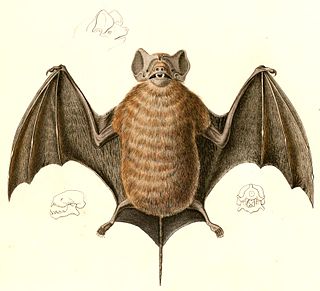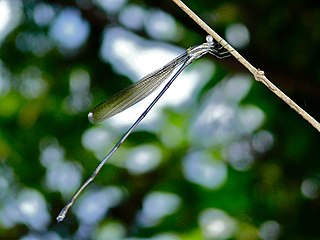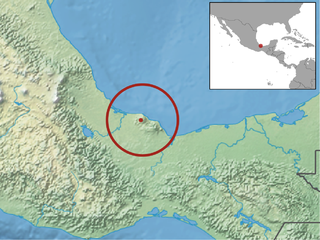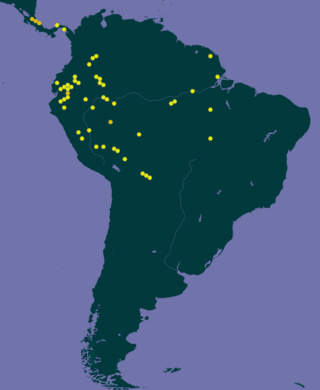
The International Union for Conservation of Nature (IUCN) Red List of Threatened Species, also known as the IUCN Red List or Red Data Book, founded in 1964, is an inventory of the global conservation status and extinction risk of biological species. A series of Regional Red Lists, which assess the risk of extinction to species within a political management unit, are also produced by countries and organizations.

Theobroma grandiflorum, commonly known as cupuaçu, also spelled cupuassu, cupuazú, cupu assu, or copoazu, is a tropical rainforest tree related to cacao.

The dingiso, also known as the bondegezou or bakaga, is an endangered, long-tailed marsupial found only in mountain forests on the west of the island of New Guinea. It is a species of tree-kangaroo, which are mammals native to Australia and New Guinea that feed on leaves or other plant matter. It belongs to the macropodid family (Macropodidae) with kangaroos, and carries its young in a pouch like most other marsupials. Though sacred to the local Moni people, it is still threatened by hunting and habitat loss.

The orange-winged amazon, also known locally as orange-winged parrot and loro guaro, is a large amazon parrot. It is a resident breeding bird in tropical South America, from Colombia, Trinidad and Tobago south to Peru, Bolivia and central Brazil. Its habitat is forest and semi-open country. Although common, it is persecuted as an agricultural pest and by capture for the pet trade. It is also hunted as a food source. Introduced breeding populations have been reported in Puerto Rico and Tenerife in the Canary Islands.

Orthetrum is a large genus of dragonflies in the Libellulidae family. They are commonly referred to as skimmers.

The velvety free-tailed bat is a species of bat found in North, Central, and South America and the Caribbean.

The ocellate river stingray, also known as the peacock-eye stingray or black river stingray, is a species of freshwater stingray in the family Potamotrygonidae. It was the first species to be described in the family and is also the most widespread, ranging throughout much of the Río de la Plata, Amazon, Mearim and Orinoco basins in tropical and subtropical South America. It is sometimes kept in aquaria.

The Pseudostigmatidae are a family of tropical damselflies, known as helicopter damselflies, giant damselflies, or forest giants. The family includes the largest of all damselfly species. They specialize in preying on web-building spiders, and breed in phytotelmata, the small bodies of water held by plants such as bromeliads.

The Amazonian black-tyrant is a species of flycatcher located in the Amazon wetlands. It is a medium-sized bird characterized by its physical features and habitat preference.

Mecistogaster is a genus of large Neotropical damselflies in the family Coenagrionidae, commonly known as helicopter damsels. There are eleven species distributed from Mexico to Argentina.
Ficus amazonica is a species of flowering plant in the family Moraceae. It is found in Brazil, Guyana, Trinidad and Tobago, and Venezuela.
Rollinia amazonica is a species of plant in the Annonaceae family. It is endemic to Colombia.

The Purús red howler is a species of howler monkey native to Brazil, Peru and north of Bolivia.

Nelson's small-eared shrew is a species of mammal in the family Soricidae. It is endemic to eastern Mexico.

Ranitomeya amazonica is a poison dart frog in the genus Ranitomeya. It was first described by Rainer Schulte in 1999 as Dendrobates amazonicus when he separated it from Dendrobates ventrimaculatus, primarily on the basis of call characteristics. The validity of the species has been debated, but further studies, also including genetic data, support its validity.

The Rio Madeira stipplethroat is a species of bird in subfamily Thamnophilinae of family Thamnophilidae, the "typical antbirds". It is found in Bolivia, Brazil, and Peru. In the past it has also been called eastern stipple-throated antwren, Madeira stipple-throated antwren, Rio Madeira antwren, and Madeira antwren.

Ormosia amazonica is a species of tree in the family Fabaceae native to the Amazon rainforest. It is naturally distributed in Brazil, Bolivia, Colombia, Costa Rica, Ecuador and Peru, in the Amazon Forest in Igarapó Forests. The species was first described by the Brazilian botanist of Austro-Hungarian origin Adolpho Ducke in 1922.
















